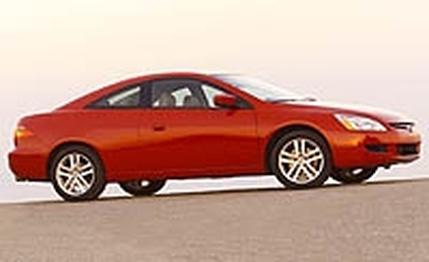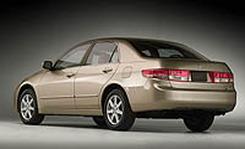
 First Drive Review
First Drive Review
The Honda Accord was the bestselling car in America last year, and since 1989, it has ranked no lower than second in the car-sales race. Moreover, Honda points out, if you ignore fleet sales, the Accord has been the best retail seller for all but one of those 13 years. The Accord has also won Car and Driver 10Best honors in 16 of the 20 years we have been conferring them. And last year we rated the current Accord, which was then four years old, better than the brand-new Nissan Altima and Toyota Camry.
With such a history of success, you couldn't blame a car company for becoming complacent. But judging by this new seventh-generation Accord, which goes on sale this month as a 2003 model, Honda is in fact running scared.
For starters, these latest Accords have all-new sheetmetal across the board, with only headlights being shared between the two-door and four-door sedans. The design intent was to make the new Accord look more "muscular, vital, and agile." Those might seem peculiar goals for a family sedan, but Honda planners see sedans evolving as personal-transportation devices, as SUVs and vans shoulder ever more of the family-hauler duties.
As a result, the new Accords have a pronounced wedge profile with what Honda describes as powerful rear haunches. The headlights are prominent and stylized, and the two-door's rear light clusters are particularly interesting, with the wedgy look of the taillights of the Mercedes CL-class.
Overall dimensions are virtually identical to those of the current models, with the biggest changes being 1.2 more inches of width in the four-door and 0.8 more inch of height in the two-door. Inside, space is much the same, although the height increase does add useful headroom in the two-door.
In keeping with Accord practice, the interior layout is clean and logical, but Honda has added a bit of razzle-dazzle for 2003. The instrument cluster, for example, employs LED illumination of the sort usually found in more expensive machinery. The gauges are completely dark when the Accord is parked, but as you open the door and insert the ignition key, the instruments light up in a neat three-stage progression. The layout on the central console is also new with no obvious demarcation between the controls for the stereo and HVAC systems. Although we had to occasionally search for the right switch, our learning curve was mercifully short.


Under the skin, the new chassis is an evolution of the current Accord. In front, the control-arm design continues, with larger brake rotors, more communicative rack-and-pinion steering, revised geometry for sharper steering response, and greater anti-dive and anti-lift characteristics. At the rear, the five-element multilink design also gets new geometry and is bolted to a stiffer subframe. All the new Accords ride on larger wheels and tires ranging from 195/65R-15s on the base DX to 215/50R-17s on the two-door EX V-6 with a manual gearbox.
You read correctly. The six-speed manual recently introduced on the Acura 3.2CL Type-S will be offered on the top two-door Accord V-6. Furthermore, this V-6, while retaining its 3.0-liter displacement, has gained a whopping 40 horsepower in the new model, for a total of 240. Credit a larger-diameter exhaust system with 30-percent-less back pressure, a retuned intake manifold coupled to a larger electronically controlled throttle body, larger intake valves, higher compression, and a more sophisticated VTEC (variable valve timing and lift) system.
The base four-cylinder also gets numerous upgrades, including i-VTEC, which adds variable cam phasing to the ability to switch between two cam profiles. This engine is very similar to the unit that powers Honda's CR-V sport-ute, and it develops 160 horsepower, up 10 from last year's. Moreover, it's a low-emissions powerplant, meeting the California LEV standards for 2004. There will even be a version, fitted with a mass-airflow sensor and larger catalyst, that satisfies the virtually emissions-free SULEV threshold.
When you order an automatic transmission with either engine, you get a wide-ratio five-speed design—that's one cog more than most cars provide in this price range. If you prefer to shift for yourself, there's a five-speed manual with the four-cylinder as well as the previously mentioned six-speed in the EX Coupe V-6. With all transmissions, fuel economy improves slightly compared with that of the current models.
Naturally, we found the V-6 two-door with the six-speed highly captivating. With 240 horses harnessed to the very slick-shifting transmission, this is one quick machine when you wind it out to its 6800-rpm redline. Yet all the thrust flowing through the front tires doesn't pollute the steering, which is notably accurate and precise. Brake feel is linear and firm, with just a hint of initial softness to ease smooth application.
With plenty of grip from the 17-inch tires and excellent control of body motions, it all adds up to an exhilarating ride on a winding country road. You might even think of this two-door V-6 Accord as the reincarnation of the much-missed Prelude, although rear-seat room is far more spacious than the Prelude's ever was.
The four-door Accord in which the V-6 is coupled to the five-speed automatic is also very satisfying. Although there's a bit less grip with the 16-inch tires, the car still feels composed and capable when driven obscenely fast. The up- and downshifts are smooth and quick, but we would have liked some sort of manumatic gate to provide the driver with more involvement. While driving sedately, we were awestruck by the silence, smoothness, and refinement that Honda has applied to this mass-market machine. Interior space is excellent, with plenty of head, hip, and knee room in the rear, although we wouldn't have minded a slightly higher seating position.
Historically, most Accord buyers opt for the four-cylinder engine, and they will not be disappointed with the new version. The 2.4-liter, balance-shaft-equipped engine could be mistaken for a good V-6 but for a slight metallic roar as it approaches its 6500-rpm redline.
What's not to like? The cowl is slightly more elevated than before, continuing the wrongheaded upward trend with every model change since the 1986 Accord, when Honda had achieved cowl-height perfection. Side-curtain airbags are few and far between, available only on the EX V-6 models. And the rear styling of the cars could be crisper and thus make a stronger statement.
Overall, the 2003 Accord represents substantial progress on almost every front. With Honda promising that the new model will be accompanied by very little in the way of price increases, this Accord promises to extend Honda's leadership in the family-sedan segment.